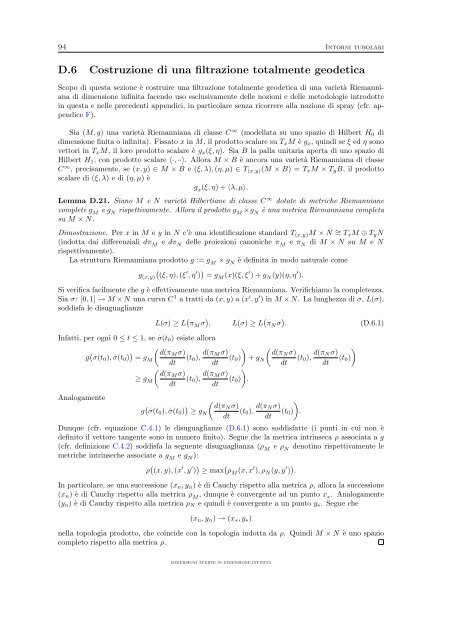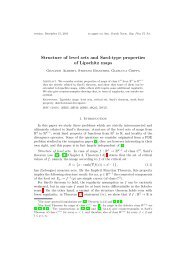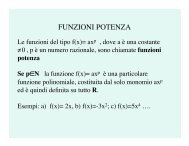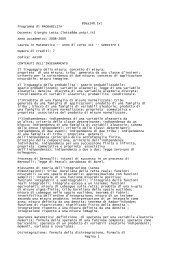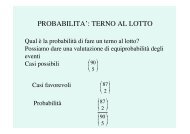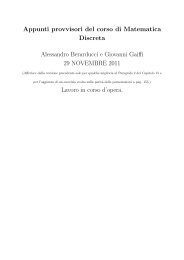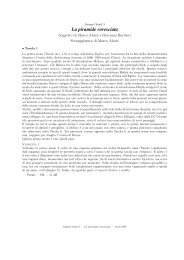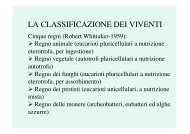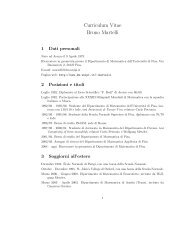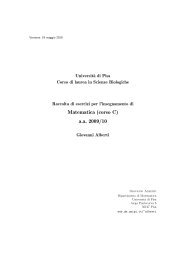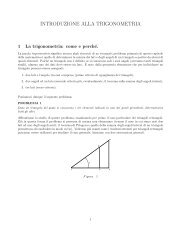Immersioni aperte in dimensione infinita - Dipartimento di Matematica
Immersioni aperte in dimensione infinita - Dipartimento di Matematica
Immersioni aperte in dimensione infinita - Dipartimento di Matematica
You also want an ePaper? Increase the reach of your titles
YUMPU automatically turns print PDFs into web optimized ePapers that Google loves.
94 Intorni tubolari<br />
D.6 Costruzione <strong>di</strong> una filtrazione totalmente geodetica<br />
Scopo <strong>di</strong> questa sezione è costruire una filtrazione totalmente geodetica <strong>di</strong> una varietà Riemanniana<br />
<strong>di</strong> <strong><strong>di</strong>mensione</strong> <strong>in</strong>f<strong>in</strong>ita facendo uso esclusivamente delle nozioni e delle metodologie <strong>in</strong>trodotte<br />
<strong>in</strong> questa e nelle precedenti appen<strong>di</strong>ci, <strong>in</strong> particolare senza ricorrere alla nozione <strong>di</strong> spray (cfr. appen<strong>di</strong>ce<br />
F).<br />
Sia (M, g) una varietà Riemanniana <strong>di</strong> classe C ∞ (modellata su uno spazio <strong>di</strong> Hilbert H0 <strong>di</strong><br />
<strong><strong>di</strong>mensione</strong> f<strong>in</strong>ita o <strong>in</strong>f<strong>in</strong>ita). Fissato x <strong>in</strong> M, il prodotto scalare su TxM è gx, qu<strong>in</strong><strong>di</strong> se ξ ed η sono<br />
vettori <strong>in</strong> TxM, il loro prodotto scalare è gx(ξ, η). Sia B la palla unitaria aperta <strong>di</strong> uno spazio <strong>di</strong><br />
Hilbert H1, con prodotto scalare 〈·, ··〉. Allora M × B è ancora una varietà Riemanniana <strong>di</strong> classe<br />
C ∞ , precisamente, se (x, y) ∈ M × B e (ξ, λ), (η, µ) ∈ T (x,y)(M × B) = TxM × TyB, il prodotto<br />
scalare <strong>di</strong> (ξ, λ) e <strong>di</strong> (η, µ) è<br />
g x(ξ, η) + 〈λ, µ〉.<br />
Lemma D.21. Siano M e N varietà Hilbertiane <strong>di</strong> classe C ∞ dotate <strong>di</strong> metriche Riemanniane<br />
complete g M e g N rispettivamente. Allora il prodotto g M ×g N è una metrica Riemanniana completa<br />
su M × N.<br />
Dimostrazione. Per x <strong>in</strong> M e y <strong>in</strong> N c’è una identificazione standard T (x,y)M × N ∼ = TxM ⊕ TyN<br />
(<strong>in</strong>dotta dai <strong>di</strong>fferenziali dπM e dπN delle proiezioni canoniche πM e πN <strong>di</strong> M × N su M e N<br />
rispettivamente).<br />
La struttura Riemanniana prodotto g := gM × gN è def<strong>in</strong>ita <strong>in</strong> modo naturale come<br />
′ ′<br />
g (x,y) (ξ, η), (ξ , η ) = gM (x)(ξ, ξ ′ ) + gN(y)(η, η ′ ).<br />
Si verifica facilmente che g è effettivamente una metrica Riemanniana. Verifichiamo la completezza.<br />
Sia σ : [0, 1] → M × N una curva C 1 a tratti da (x, y) a (x ′ , y ′ ) <strong>in</strong> M × N. La lunghezza <strong>di</strong> σ, L(σ),<br />
sod<strong>di</strong>sfa le <strong>di</strong>suguaglianze<br />
L(σ) ≥ L π M σ , L(σ) ≥ L π N σ . (D.6.1)<br />
Infatti, per ogni 0 ≤ t ≤ 1, se . σ(t0) esiste allora<br />
g .<br />
σ(t0), . σ(t0) <br />
d(πM σ)<br />
= gM (t0),<br />
dt<br />
d(πM<br />
<br />
σ)<br />
d(πN σ)<br />
(t0) + gN (t0),<br />
dt<br />
dt<br />
d(πNσ)<br />
<br />
(t0)<br />
dt<br />
<br />
d(πM σ)<br />
≥ gM (t0),<br />
dt<br />
d(πM<br />
<br />
σ)<br />
(t0) .<br />
dt<br />
Analogamente<br />
g . σ(t0), . σ(t0) ≥ g N<br />
d(πNσ)<br />
dt<br />
(t0), d(πN<br />
<br />
σ)<br />
(t0) .<br />
dt<br />
Dunque (cfr. equazione C.4.1) le <strong>di</strong>suguaglianze (D.6.1) sono sod<strong>di</strong>sfatte (i punti <strong>in</strong> cui non è<br />
def<strong>in</strong>ito il vettore tangente sono <strong>in</strong> numero f<strong>in</strong>ito). Segue che la metrica <strong>in</strong>tr<strong>in</strong>seca ρ associata a g<br />
(cfr. def<strong>in</strong>izione C.4.2) sod<strong>di</strong>sfa la seguente <strong>di</strong>suguaglianza (ρ M e ρ N denot<strong>in</strong>o rispettivamente le<br />
metriche <strong>in</strong>tr<strong>in</strong>seche associate a g M e g N ):<br />
ρ (x, y), (x ′ , y ′ ) ≥ max ρ M (x, x ′ ), ρ N(y, y ′ ) .<br />
In particolare, se una successione (xn, yn) è <strong>di</strong> Cauchy rispetto alla metrica ρ, allora la successione<br />
(xn) è <strong>di</strong> Cauchy rispetto alla metrica ρ M , dunque è convergente ad un punto x ∗. Analogamente<br />
(yn) è <strong>di</strong> Cauchy rispetto alla metrica ρN e qu<strong>in</strong><strong>di</strong> è convergente a un punto y∗. Segue che<br />
(xn, yn) → (x∗, y∗)<br />
nella topologia prodotto, che co<strong>in</strong>cide con la topologia <strong>in</strong>dotta da ρ. Qu<strong>in</strong><strong>di</strong> M × N è uno spazio<br />
completo rispetto alla metrica ρ.<br />
IMMERSIONI APERTE IN DIMENSIONE INFINITA


